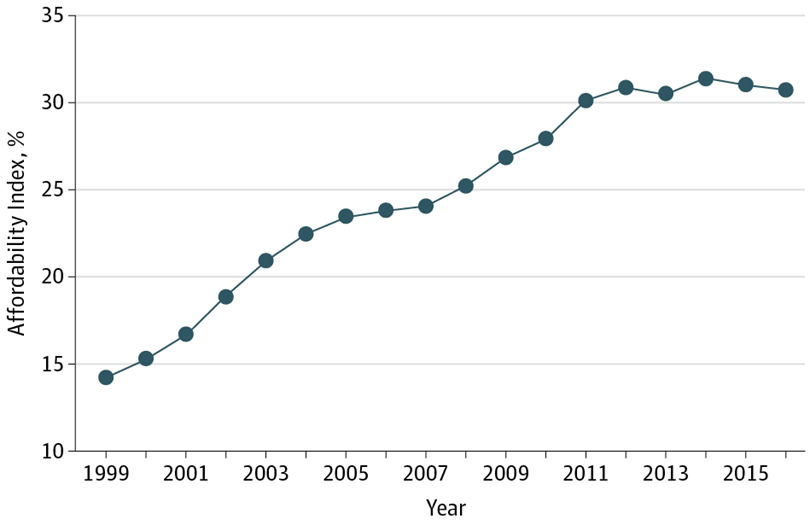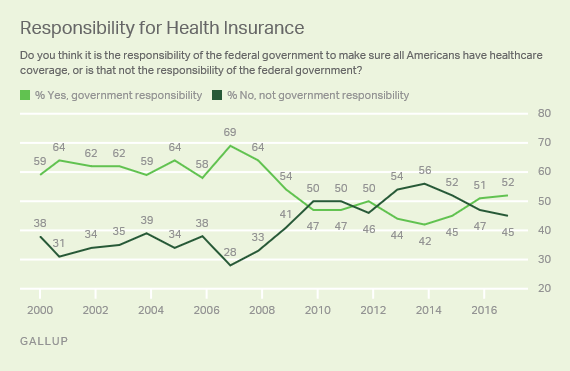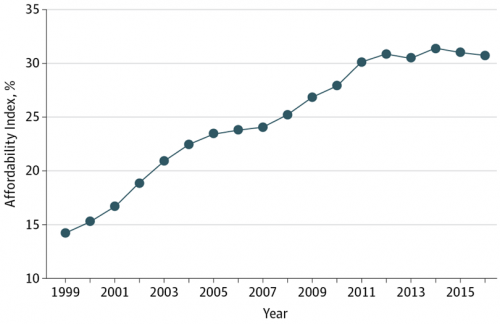 The math is straightforward. Assume “A” equals $59.039, the median household income in 2016. Assume “B” is $18,142, the mean employer-sponsored family insurance premium last year. B divided by A equals 30.7%, which is the percent of the average U.S. family’s income represented by the premium cost of health insurance.
The math is straightforward. Assume “A” equals $59.039, the median household income in 2016. Assume “B” is $18,142, the mean employer-sponsored family insurance premium last year. B divided by A equals 30.7%, which is the percent of the average U.S. family’s income represented by the premium cost of health insurance.
Compare that to what American households spent on food: just over $7,000, including groceries and eating out (which is garnering a larger share of U.S. eating opportunities, a topic for another post).
Thus, health care represents, via the home’s health insurance premium, represents 2.5 times more than food for the average U.S. household.
This health arithmetic relationship/reality is featured in a viewpoint written by Zeke Emanuel and Aaron Glickman in yesterday’s JAMA (published online 2nd November 2017) in an article titled, Measuring the Burden of Health Care Costs on US Families: The Affordability Index.
The Index is illustrated in the graph, which shows a steadily-increasing line based on the B divided by A calculation of health insurance premium cost over median family income. As health care costs have risen and wages have remained relatively flat over the years 1999 to 2012, the Index grows hockey-stick style. By 2013 to 2016, the Index flattens, as health care costs increased more modestly and wages began to rise a bit in the past couple of years.
Health Populi started publishing ten years ago, with the earliest posts focused on the peoples’ (“Populi”) personal health economics, which this first post discussed a decade ago. Plus ça change…
 Health Populi’s Hot Points: Affordability of health care is Americans most urgent health problem, according to a 2016 Gallup poll, the authors note. The green chart comes from Gallup, and shows an uptick to a majority of Americans who believe the government should be responsible for all health citizens to have health insurance coverage.
Health Populi’s Hot Points: Affordability of health care is Americans most urgent health problem, according to a 2016 Gallup poll, the authors note. The green chart comes from Gallup, and shows an uptick to a majority of Americans who believe the government should be responsible for all health citizens to have health insurance coverage.
Dealing with personal and family health care costs are now part of the patient experience, and billing has become part of UX design for healthcare Chief Financial Officers who have revenue cycle management as Job 1.
While the plateauing of the Affordability Index is good news, U.S. families continue to allocate, on average, at least $1 in every $5 of household spending to healthcare costs, which rank above pocketbook concerns for housing, food, and utilities. Healthcare costs are integral to the financial health of U.S. families.





 Interviewed live on BNN Bloomberg (Canada) on the market for GLP-1 drugs for weight loss and their impact on both the health care system and consumer goods and services -- notably, food, nutrition, retail health, gyms, and other sectors.
Interviewed live on BNN Bloomberg (Canada) on the market for GLP-1 drugs for weight loss and their impact on both the health care system and consumer goods and services -- notably, food, nutrition, retail health, gyms, and other sectors. Thank you, Feedspot, for
Thank you, Feedspot, for  As you may know, I have been splitting work- and living-time between the U.S. and the E.U., most recently living in and working from Brussels. In the month of September 2024, I'll be splitting time between London and other parts of the U.K., and Italy where I'll be working with clients on consumer health, self-care and home care focused on food-as-medicine, digital health, business and scenario planning for the future...
As you may know, I have been splitting work- and living-time between the U.S. and the E.U., most recently living in and working from Brussels. In the month of September 2024, I'll be splitting time between London and other parts of the U.K., and Italy where I'll be working with clients on consumer health, self-care and home care focused on food-as-medicine, digital health, business and scenario planning for the future...